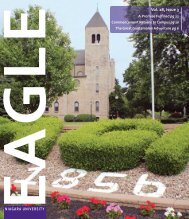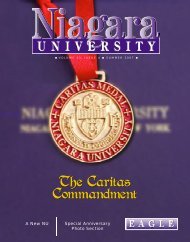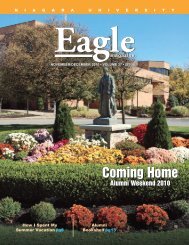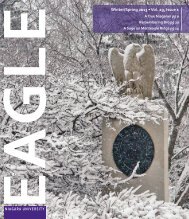Fall 2011 ⢠Vol. 28, Issue 1 - Eagle Online - Niagara University
Fall 2011 ⢠Vol. 28, Issue 1 - Eagle Online - Niagara University
Fall 2011 ⢠Vol. 28, Issue 1 - Eagle Online - Niagara University
You also want an ePaper? Increase the reach of your titles
YUMPU automatically turns print PDFs into web optimized ePapers that Google loves.
ON THE RIDGE<br />
Professor Teaching Students History 140 Characters at a Time<br />
By Mike Freedman<br />
6<br />
With each passing tweet, it’s become<br />
more and more apparent that<br />
people are turning to Twitter to<br />
access breaking news. But will college students<br />
turn to the social networking website to learn<br />
about events that have already taken place?<br />
Dr. Mustafa Gökçek hopes so.<br />
e <strong>Niagara</strong> <strong>University</strong> assistant professor of<br />
history has compiled a list of 90 major<br />
chronological events that took place between<br />
1945 and 2005. He began disseminating them<br />
as tweets on Sept. 13. Each tweet, a post or<br />
status update on Twitter that can contain a<br />
maximum of 140 characters, will include a link<br />
to a primary source that provides more<br />
information on the event.<br />
e tweets will be sent under the handle of<br />
NUHIS199, a reference to Dr. Gökçek’s course<br />
on America and the Contemporary World.<br />
“A vast majority of our students already have<br />
Twitter accounts and I’m hoping that this will<br />
be a way of making learning about history more<br />
fun,” says Dr. Gökçek. “I have always been<br />
interested in utilizing the latest technology in<br />
my class.”<br />
In the past, students in Dr. Gökçek’s Middle<br />
East history class made short documentaries<br />
using video editing software. He has also used<br />
Skype to video conference in his classes with<br />
students in China and Egypt. Several of Dr.<br />
Gökçek’s colleagues in NU’s History Department<br />
have introduced Facebook as a tool to communicate<br />
with students.<br />
For his newest endeavor, Dr. Gökçek is adopting<br />
software that was developed by Dr. Murat<br />
Demirbas, an associate professor of computer<br />
science at the <strong>University</strong> of Buffalo. e program<br />
was developed to send tweets at scheduled<br />
intervals, making it possible to cover 60 years of<br />
history by sending 90 tweets in 90 days, the<br />
approximate duration of the fall semester.<br />
Dr. Gökçek takes the project one step further.<br />
Instead of simply sending out one tweet daily,<br />
the computer program can be manipulated so<br />
that one historical year translates to one and a<br />
half days. erefore, if two events occurred one<br />
year apart, the tweets profiling those events will<br />
be sent one and a half days from each other. If<br />
they took place two years apart, there will be a<br />
three-day difference between tweets, and so on.<br />
“e nature of this project will help students<br />
better understand the timeline of major events,<br />
the time difference between each one, and the<br />
historical context in which each event took<br />
place,” explains Dr. Gökçek. “It will also<br />
encourage the students to follow the links to<br />
primary sources and contribute more effectively<br />
in class discussions.”<br />
Students enrolled in HIS199 have taken to the<br />
project. ose without Twitter accounts have<br />
registered with the site. At the end of the<br />
semester, they will prepare poster presentations<br />
based on what they’ve learned throughout<br />
the experience. Based on this project’s success,<br />
Dr. Gökçek and his colleagues will explore making<br />
the format applicable to other courses and perhaps<br />
even adding a testing component.<br />
“This is certainly quite a new project for all of<br />
us and we are all excited to be a part of it,” says<br />
Dr. Gökçek. “We encourage anyone who is<br />
interested to follow us on Twitter.”














